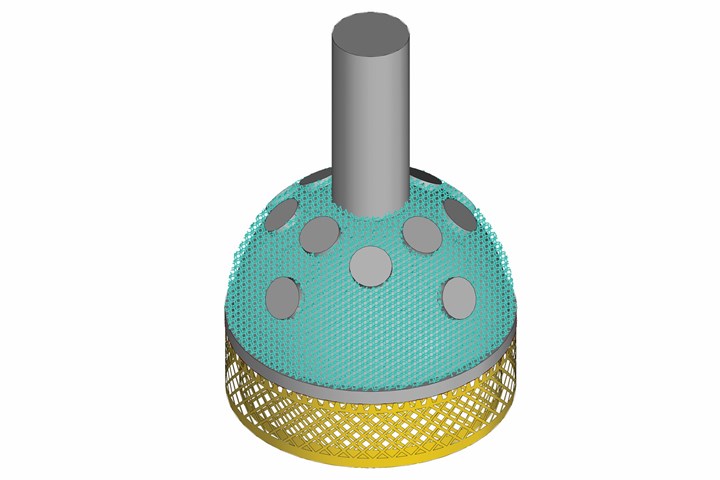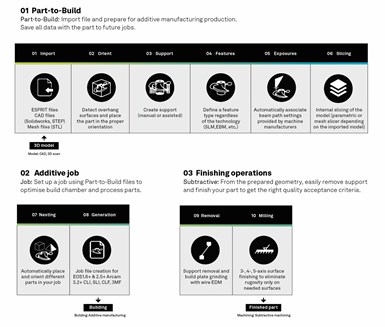CAM Software’s Additive Build Preparation Workflow Streamlines Hybrid Manufacturing
Hexagon implements a Part-to-Build digital workflow within ESPRIT CAM, to aid in streamlining powder bed fusion (PBF) builds and finishing operations in a single CAM environment.

ESPRIT CAM hip cup part with parametric support structures and mesh lattice. Photo Credit, all images: Hexagon
ESPRIT CAM software introduced by Hexagon’s Manufacturing Intelligence division now offers users the digital tools needed to prepare 3D-printed components for manufacturing using powder bed fusion (PBF) technologies. Because hybrid manufacturing entails performing both additive and subtractive processes, Hexagon notes, integrating build preparation tools within CAM software streamlines workflows per part and offers efficiency improvements when scaling up additive manufacturing (AM) volumes.
Specifically, the build preparation workflow within the CAM environment provides a single, streamlined platform for both the additive build and finishing operations. Hexagon says the patented Part-to-Build workflow was developed to change the prevailing 3D-printing paradigm from the preparation of rapid prototypes to industrialization with CAM that includes build preparation steps and the programming tools for post-processing printed parts with wire EDM machining and milling machine tools. Part-to-Build addresses part preparation and job preparation with dedicated functionality within one piece of software, enabling volume efficiencies and automating repetitive tasks, such as slicing.
Designed for CAM programmers, ESPRIT CAM’s build preparation employs a workflow based on parametric data that ensures high accuracy and adherence to the geometry of the original CAD model until it is sliced in preparation for 3D printing. The software reads and manipulates all popular parametric CAD formats and automatically identifies those surfaces that require support. The software also assists with the creation of support structures, generating parametric surfaces with teeth, fragmentation and perforation. Support generation can be automated for future builds by assigning a preset to a region in the surface, capturing production know-how and improving future productivity. Because the majority of models for 3D-printed parts are STL-based, ESPRIT CAM also provides an STL (mesh) slicer that leverages a built-in software kernel.
According to Hexagon, once a part is sliced, it can be imported to the software’s job preparation environment and re-used whenever needed. Here, exposure strategies are automatically assigned according to the chosen machine setup. As the part is already sliced, the programmer need only nest them and the corresponding machine file is generated based on the target machine setup.
ESPRIT Additive PBF can be used in conjunction with other Hexagon products, such as MSC Apex Generative Design and Simufact Additive.
Related Content
-
What is Scientific Maintenance? Part 2
Part two of this three-part series explains specific data that toolrooms must collect, analyze and use to truly advance to a scientific maintenance culture where you can measure real data and drive decisions.
-
Tolerancing in Mold Design, Part 1: Understanding the Issues of Conventional Bilateral Tolerancing
Mold designers must understand the location, orientation and form limitations of conventional tolerancing before changing to another dimensioning system.
-
The In's and Out's of Ballbar Calibration
This machine tool diagnostic device allows the detection of errors noticeable only while machine tools are in motion.












_300x250 1.png;maxWidth=300;quality=90)

.png;maxWidth=300;quality=90)


